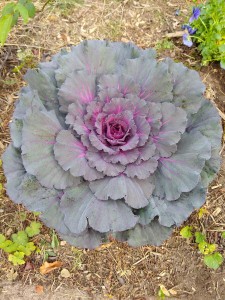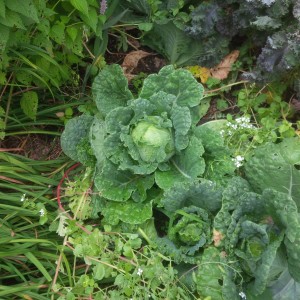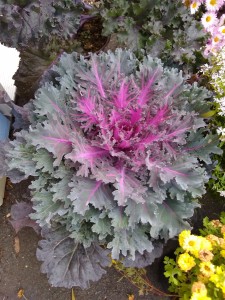 A few years ago, I bought several gorgeous ornamental cabbages to brighten up my late fall garden. I love cabbage and its relative, kale, in my borders, but I hate it on my plate. Because of that, I assumed that the resident varmints would feel the same way.
A few years ago, I bought several gorgeous ornamental cabbages to brighten up my late fall garden. I love cabbage and its relative, kale, in my borders, but I hate it on my plate. Because of that, I assumed that the resident varmints would feel the same way.
I was wrong.
Two days after I installed my new cabbages, I found that they had been eaten almost down to the ground. The prime suspect was our resident groundhog, who, in his fall incarnation, looked like a furry brown beach ball. The experience put me off ornamental cabbages and kales for quite awhile.
Now, however, I am older and wiser and have a large container of organic deer and varmint repellant. I saw some lovely kales at a garden center and bought a large one. I will spray it with the foul-smelling stuff and enjoy the color it brings to my landscape. I might even buy a few more, as long as the supply of repellent holds out.
Humans have been eating cabbage, kale and their Brassica or mustard family relatives, for millennia. All cabbages are kales, but not all kales are cabbages. If you are confused about the differences between ornamental cabbage and kale, rest easy. The next time you see one or the other, check out the leaves. Cabbage leaves are rounded, while kale leaves are jagged or frilly looking. Beautiful varieties of both are abundant in garden centers.
Kale started out as a food crop in the Mediterranean, where it was enjoyed by the ancient Romans, among others. It migrated to many places, including China, where it became a dietary staple. Eventually kale arrived in Japan, where gardeners saw its ornamental value and most likely started selecting out the most attractive specimens. As early as the seventeenth century, kale appeared as an ornamental in Japanese gardens.
In 1929 the United State Department of Agriculture was on the hunt for new plants for the American market and sent an official, Howard Dorsett, to Japan and China to see what he could find. A lovely kale caught his eye in Japan and he brought it back. Six years later it was in commercial cultivation and in home gardens. Now kale and cabbage are almost as integral to outdoor fall décor as pumpkins. They pop up in mass plantings at theme parks and islands in front of gas stations. Presumably in those places high human or automobile traffic deter the groundhogs that devoured my earlier cabbages.
Cabbages and kales are cool season crops, which makes the ornamental varieties perfect for fall gardens. Their leaves, adorned with shades of green, cream, pink and purple go with just about anything and look especially good with fall mums, asters and pansies. Best of all, the largest ones take up a good deal of real estate, which is perfect for camouflaging the holes left by departed summer annuals. Depending on weather, cabbages and kales may last well into the winter.
The specimens you see in garden centers are not always labeled with varietal names, but a few varieties stand out. I like ‘Osaka’ cabbage, with blue-green leaves and contrasting centers of cream or pink. ‘Tokyo’ is similar, but even more rounded. For purple drama, try ‘Chidori’, a kale with deep purple, frilly leaves and contrasting center. Every place that sells fall plants has similar varieties and the combinations of frills ruffles and soft colors make them irresistible.
Most of the specimens available at plant retailers are full grown and a little pot-bound. This means that the size you buy is the size you are stuck with, so plan and purchase accordingly. The plants like full sun and the colors deepen as the temperature falls. They work equally well in large pots or garden beds. Mass plantings of single or harmoniously colored varieties will look like a vibrant patchwork quilt. You can also ring them with pansies or use them at the feet of tall asters. When the asters fade, you will still have a great autumn show.
Can humans eat ornamental kale? Yes, but most of us would not want to, as the leaves are much more bitter than those of varieties grown as food crops. Restaurants sometimes use individual kale leaves as garnishes, secure in the knowledge that few people will eat them. For my money, it is much better to garnish with a squirt of sauce or a few sprigs of parsley and use the ornamental kales and cabbages as part of a recipe for a delicious-looking fall garden.
